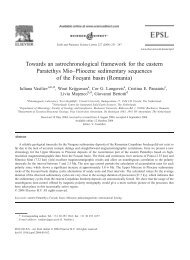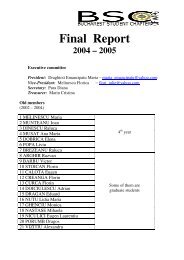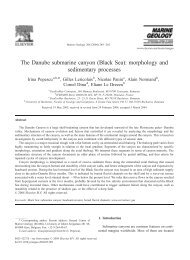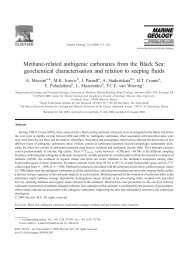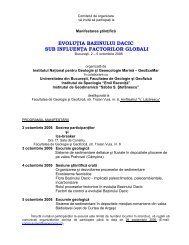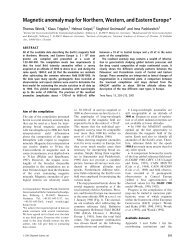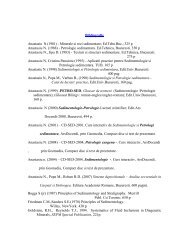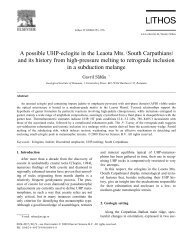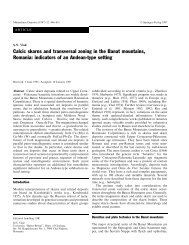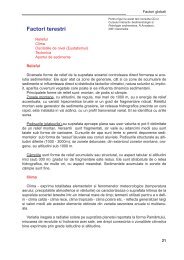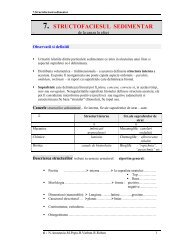Lateglacial and early Holocene vegetation ... - geo.edu.ro
Lateglacial and early Holocene vegetation ... - geo.edu.ro
Lateglacial and early Holocene vegetation ... - geo.edu.ro
You also want an ePaper? Increase the reach of your titles
YUMPU automatically turns print PDFs into web optimized ePapers that Google loves.
L. Bj .orkman et al. / Quaternary Science Reviews 21 (2002) 1039–1059 1045<br />
4.3. Pollen stratigraphy <st<strong>ro</strong>ng>and</st<strong>ro</strong>ng> <st<strong>ro</strong>ng>vegetation</st<strong>ro</strong>ng> development<br />
The pollen data are presented in percentage diagrams<br />
with all terrestrial pollen types included in the calculation<br />
sum(Figs. 4 <st<strong>ro</strong>ng>and</st<strong>ro</strong>ng> 5). To facilitate the description<br />
<st<strong>ro</strong>ng>and</st<strong>ro</strong>ng> interpretation of these pollen diagrams in terms<br />
of <st<strong>ro</strong>ng>vegetation</st<strong>ro</strong>ng> changes 12 local pollen assemblages<br />
zones were established for Preluca Tiganului (LPAZ<br />
P1–P12; Table 3, Fig. 4), <st<strong>ro</strong>ng>and</st<strong>ro</strong>ng> eleven zones for<br />
Steregoiu (LPAZ S1–S11; Table 4, Fig. 5). These<br />
zones have been established visually, <st<strong>ro</strong>ng>and</st<strong>ro</strong>ng> each zone<br />
boundary denotes significant changes in pollen<br />
deposition, <st<strong>ro</strong>ng>and</st<strong>ro</strong>ng> hence represents major changes in<br />
<st<strong>ro</strong>ng>vegetation</st<strong>ro</strong>ng> cover. The validity of these zones has<br />
also been confirmed by using an independent multivariate<br />
method (CONISS). As the pollen data set is<br />
very large, we focus in this paper on upl<st<strong>ro</strong>ng>and</st<strong>ro</strong>ng> woodl<st<strong>ro</strong>ng>and</st<strong>ro</strong>ng><br />
development only (the pollen diagrams show<br />
all identified tree pollen types, but only selected<br />
herb <st<strong>ro</strong>ng>and</st<strong>ro</strong>ng> shrub pollen types). The on-site <st<strong>ro</strong>ng>vegetation</st<strong>ro</strong>ng><br />
<st<strong>ro</strong>ng>and</st<strong>ro</strong>ng> site development will be discussed in detail elsewhere.<br />
4.4. <st<strong>ro</strong>ng>Lateglacial</st<strong>ro</strong>ng> <st<strong>ro</strong>ng>and</st<strong>ro</strong>ng> <st<strong>ro</strong>ng>early</st<strong>ro</strong>ng> <st<strong>ro</strong>ng>Holocene</st<strong>ro</strong>ng> <st<strong>ro</strong>ng>vegetation</st<strong>ro</strong>ng><br />
development in the Gutaiului Mountains, a synthesis<br />
We present here a synthesis of the <st<strong>ro</strong>ng>Lateglacial</st<strong>ro</strong>ng> <st<strong>ro</strong>ng>and</st<strong>ro</strong>ng><br />
Early <st<strong>ro</strong>ng>Holocene</st<strong>ro</strong>ng> woodl<st<strong>ro</strong>ng>and</st<strong>ro</strong>ng> development in the study<br />
area as reconstructed f<strong>ro</strong>mthe pollen data <st<strong>ro</strong>ng>and</st<strong>ro</strong>ng> AMS 14 C<br />
measurements (Figs. 4 <st<strong>ro</strong>ng>and</st<strong>ro</strong>ng> 5; Tables 3 <st<strong>ro</strong>ng>and</st<strong>ro</strong>ng> 4). For the<br />
period >14,700 cal. years BP, the synthesis is based on<br />
LPAZ S1 only, <st<strong>ro</strong>ng>and</st<strong>ro</strong>ng> for the period 14,700–13,800 cal.<br />
years BP, LPAZ S2 <st<strong>ro</strong>ng>and</st<strong>ro</strong>ng> LPAZ P2–P4 have been used.<br />
Between 13,800 <st<strong>ro</strong>ng>and</st<strong>ro</strong>ng> c. 8500 cal. years BP, the inferred<br />
<st<strong>ro</strong>ng>vegetation</st<strong>ro</strong>ng> development is based on local pollen<br />
assemblages zones f<strong>ro</strong>m both sites.<br />
Before 14,700 cal. years BP, the area was dominated<br />
by open <st<strong>ro</strong>ng>vegetation</st<strong>ro</strong>ng>, which was most likely composed of<br />
a patchy mosaic with low shrubs, such as Salix <st<strong>ro</strong>ng>and</st<strong>ro</strong>ng><br />
Juniperus (possibly also Betula), <st<strong>ro</strong>ng>and</st<strong>ro</strong>ng> grasses, sedges <st<strong>ro</strong>ng>and</st<strong>ro</strong>ng><br />
herbs, such as Artemisia <st<strong>ro</strong>ng>and</st<strong>ro</strong>ng> Chenopodiaceae. However,<br />
patches with un-vegetated g<strong>ro</strong>und also occurred. Pinus<br />
may have g<strong>ro</strong>wn in valleys, where favourable mic<strong>ro</strong>climatic<br />
conditions prevailed, or could have formed open<br />
forests in lowl<st<strong>ro</strong>ng>and</st<strong>ro</strong>ng> areas.<br />
4.4.1. 14,700–14,150 cal. years BP<br />
The reconstructed <st<strong>ro</strong>ng>vegetation</st<strong>ro</strong>ng> consisted of a mosaic<br />
of scattered Pinus trees, low shrubs, such as Salix <st<strong>ro</strong>ng>and</st<strong>ro</strong>ng><br />
Juniperus, <st<strong>ro</strong>ng>and</st<strong>ro</strong>ng> grasses, sedges <st<strong>ro</strong>ng>and</st<strong>ro</strong>ng> herbs, such<br />
as Artemisia <st<strong>ro</strong>ng>and</st<strong>ro</strong>ng> Chenopodiaceae. Areas with<br />
un-vegetated g<strong>ro</strong>und may have existed. The occurrence<br />
of scattered pollen grains of Picea might suggest that it<br />
was present on favourable sites in valleys at lower<br />
altitudes.<br />
4.4.2. 14,150–14,050 cal. years BP<br />
During this time period, the upl<st<strong>ro</strong>ng>and</st<strong>ro</strong>ng> <st<strong>ro</strong>ng>vegetation</st<strong>ro</strong>ng><br />
changed into open forests, in which Pinus <st<strong>ro</strong>ng>and</st<strong>ro</strong>ng><br />
Betula were common. There is evidence for a local<br />
expansion of carr forest at Preluca Tiganului<br />
(mainly Betula) <st<strong>ro</strong>ng>and</st<strong>ro</strong>ng> Steregoiu (mainly Alnus). Patches<br />
of open <st<strong>ro</strong>ng>vegetation</st<strong>ro</strong>ng> p<strong>ro</strong>bably also occurred in the<br />
region, but these were most likely restricted to higher<br />
altitudes.<br />
4.4.3. 14,050–13,800 cal. years BP<br />
The return to open <st<strong>ro</strong>ng>vegetation</st<strong>ro</strong>ng> with scattered Pinus<br />
individuals characterises this time slice. The <st<strong>ro</strong>ng>vegetation</st<strong>ro</strong>ng><br />
may have comprised mosaic patches with low shrubs<br />
<st<strong>ro</strong>ng>and</st<strong>ro</strong>ng> scattered trees, such as Salix, Juniperus <st<strong>ro</strong>ng>and</st<strong>ro</strong>ng> Pinus,<br />
<st<strong>ro</strong>ng>and</st<strong>ro</strong>ng> patches with grasses, sedges <st<strong>ro</strong>ng>and</st<strong>ro</strong>ng> herbs, such as<br />
Artemisia <st<strong>ro</strong>ng>and</st<strong>ro</strong>ng> Chenopodiaceae. The low pollen values<br />
for Picea might suggest that it was present regionally,<br />
p<strong>ro</strong>bably on favourable sites in valleys. Mac<strong>ro</strong>fossils of<br />
several Pinus species (P. sylvestris, P. mugo <st<strong>ro</strong>ng>and</st<strong>ro</strong>ng><br />
P. cembra) as well as remains of Populus <st<strong>ro</strong>ng>and</st<strong>ro</strong>ng> Larix<br />
have been identified in sediments corresponding to this<br />
period by Wohlfarth et al. (in press). However, pollen<br />
grains of Populus <st<strong>ro</strong>ng>and</st<strong>ro</strong>ng> Larix have not been found in the<br />
present study.<br />
4.4.4. 13,800–12,950 cal. years BP<br />
F<strong>ro</strong>m13,800 cal. years BP onwards, open forests with<br />
Betula, Picea <st<strong>ro</strong>ng>and</st<strong>ro</strong>ng> Pinus occurred in the area. During the<br />
middle part of the period, Ulmus shows remarkably high<br />
values, which may imply that it was locally abundant.<br />
The seemingly rapid expansion, initially of Picea, <st<strong>ro</strong>ng>and</st<strong>ro</strong>ng><br />
later of Ulmus, indicates that they had been present<br />
already earlier in the region, however, in very low<br />
numbers. Areas with open <st<strong>ro</strong>ng>vegetation</st<strong>ro</strong>ng> were likely to have<br />
been restricted to higher altitudes. Mac<strong>ro</strong>scopic charcoal<br />
gives additional information when interpreting<br />
pollen data, as it is believed that such charcoal<br />
represents local fires (Patterson et al., 1987; Clark,<br />
1988). In the study by Wohlfarth et al. (in press),<br />
mac<strong>ro</strong>scopic charcoal was found in sediments f<strong>ro</strong>m<br />
Preluca Tiganului at levels that correlate to this period.<br />
Picea is fire sensitive <st<strong>ro</strong>ng>and</st<strong>ro</strong>ng> shows highly variable values in<br />
LPAZ P5 (Fig. 4). It is therefore tempting to attribute<br />
the decrease of Picea at c. 8.40 <st<strong>ro</strong>ng>and</st<strong>ro</strong>ng> 8.20 mto local forest<br />
fires.<br />
4.4.5. 12,950–12,600 cal. years BP<br />
This time period is characterised by open Betula,<br />
Pinus <st<strong>ro</strong>ng>and</st<strong>ro</strong>ng> Picea forests. Ulmus had p<strong>ro</strong>bably diminished<br />
already during the beginning of the period. Betula, Pinus<br />
<st<strong>ro</strong>ng>and</st<strong>ro</strong>ng> Picea appear to have decreased rapidly, at the same<br />
time as Artemisia <st<strong>ro</strong>ng>and</st<strong>ro</strong>ng> Chenopodiaceae in particular<br />
exp<st<strong>ro</strong>ng>and</st<strong>ro</strong>ng>ed st<strong>ro</strong>ngly. At a<strong>ro</strong>und 12,600 cal. years BP, the<br />
forest <st<strong>ro</strong>ng>vegetation</st<strong>ro</strong>ng> became severely r<st<strong>ro</strong>ng>edu</st<strong>ro</strong>ng>ced, <st<strong>ro</strong>ng>and</st<strong>ro</strong>ng> p<strong>ro</strong>bably<br />
only open woodl<st<strong>ro</strong>ng>and</st<strong>ro</strong>ng> of Betula <st<strong>ro</strong>ng>and</st<strong>ro</strong>ng> Picea existed locally.



